When I began collecting trading cards, I often wondered what the best way to organize Pokemon cards in binders was, but that thought never translated into action. Despite my wondering, I ended up with most of my collection stashed in boxes with half-empty binders sitting on shelves. Now 20 years wiser, I hope I can offer help to a few of you looking for a better way to organize your Pokemon cards in binders.
The best way to organize Pokémon cards in binders for players is by rarity. Placing the rarest Pokémon cards at the front of the binder and the rest in descending order towards the back. However, organizing Pokémon cards by set number may be more advantageous for Pokémon card collectors.
There are a number of options to consider when trying to decide on how best to organize your Pokémon card collection for your individual needs.
However, it’s not as daunting of a task as you might first believe, there a few simple tips that can make the whole process much easier!
The best way to organize your Pokémon cards in binders.
Not every keeper of Pokémon cards is the same, but normally we can break down Pokémon card lovers into 3 main categories:
1. The Beginner
If you are less than 6 months – 1 year into this cardboard hobby then more than likely you will fit into this category. Your collection of Pokémon cards will be relatively small and all of the cards that you care about will likely fit into a single binder.
You may find yourself playing the game casually with friends or online and occasionally heading down to your local card shop to take part in any events that might be happening. This is where I, and most people, start their TCG Journey and is a great place to be.
2. The Player
If you find that most of your card collection centers around competitive decks for either Pokémon’s standard or extended formats, then this is you – this was also me for a good period of time.
Players will often find themselves with a lot of bulk cards in their collection from the occasional pack or booster box opening, but will tend to get the cards they want through trading or buying the singles they need to finish the deck they’re working on.
The organizational needs of the Player focus more on being able to put decks together fast and efficiently, so they can get back to playing as soon as possible.
3. The Collector
If you don’t have a great interest in playing the Pokémon trading card game, but can’t stop yourself from cracking booster packs – then the Collector you have become.
Out of all of the types mentioned, the collector is the one that needs to be thinking about binder organization the most. A collector’s collection can quickly get out of hand if you don’t have a plan in place.
However, having a well-organized large collection of Pokémon card binders is one of the most satisfying feelings for us cardboard keepers.
Often, we’ll find ourselves to be some kind of hybrid between all 3 of these types and overtime change from one to another.
In any case, the first step to understanding the best way to organize your Pokémon cards in binders is to understand which of these types of Pokémon card lovers you align with the most.
It’s fine to be 50/50, I was, you just might have to combine some of the tips below to get the best organizational system for you.

Organizing Pokemon Cards Using Binders For Beginners
Binders are a fantastic way to get started collecting Pokémon cards as a beginner.
I recommend if you’re just getting started to get a hold of a small 4×4 binder.
Chances are when you’re just starting out, you won’t have a large amount of Pokemon cards to organize, and having something small to take with you to local events is handy.
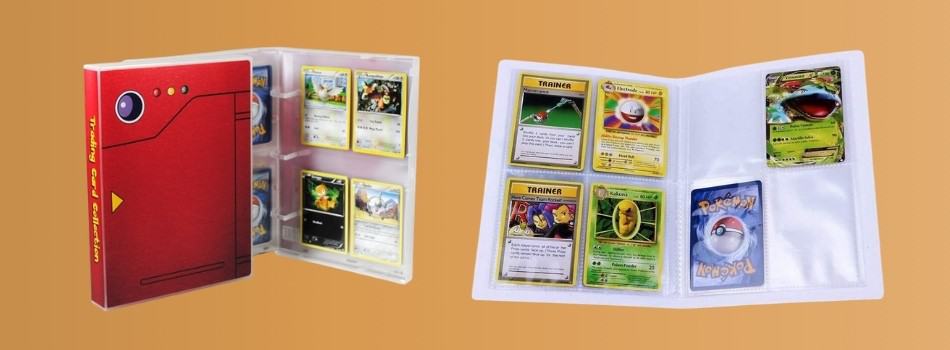
When organizing your Pokémon cards, keep your highest rarity cards that you are interested in trading away at the front of your binder, and keep the cards you want to hold on to at the back.
Pro Tip: Place the cards you want to keep upsidedown in your trade binder. It’s a simple way of telling people that look through your binder that you aren’t interested in trading those specific cards away.
Chances are, if you’re a beginner, you may already have a deck or two built for casual or competitive play. Just leave those cards as they are together in a deck box and keep the rest in your trade binder, with the exception of basic energy cards.
When you are just starting out, you typically won’t have a good sense of what cards do and don’t hold value – when I started playing TCGs, I often left cards at home that people wanted to trade for; missing out on cards I wanted in return.
Basic energies can be left out of your binder for the most part; it’s pretty rare that you will meet someone looking to trade for energy even if they’re foils.
For now, with your basic energy cards, I would recommend storing a handful of each energy type neatly in a box in case you suddenly get the urge to build a new kind of deck. Otherwise, I recommend getting into the habit of donating your spare energy cards to your local card shop. Often, card shops can always use extra energy cards when they run in-store events.
Why I recommend a small 4×4 binder compared to a slightly larger binder for beginners is that you won’t outgrow a use for your 4×4 binder later down the line.

As you continue to grow in the hobby and decide to collect more cards, you will always have a need for a small trade binder.
later on, you can upgrade to binders more appropriate to competitive play or collecting Pokémon cards without having to throw away your first binder and wasting money.
My general rule when buying binders to organize Pokemon cards is go big or go small – Goldilocks isn’t welcome here.
Let’s avoid wasting money on things we’ll eventually outgrow that could have been used to buy more cards!

Organizing Pokemon Cards Using Binders For Competitive Standard Players
I recommend getting a 4 row Pokémon card binder for competitive standard Pokémon players.
These binders are incredibly helpful to players to tell at a quick glance if they have a full playset of a card or how many you need to complete the set. It can really take out some of the guesswork if you are the type of player that likes to regularly build or rebuild decks.

In terms of organization styles for your 4-row binders, I recommend having your double prize cards at the front of your binder or simply organizing the binder from most rare cards to least, front to back.
While not always the case, more often than not, the general rule is:
The rarer a Pokémon card is in a standard set, the more likely it is to be the core of a deck in the meta.
Meaning, organizing these cards at the front of your binder is a fast way to know if you have the essential cards needed to build a certain deck in the current meta.
Starting from the back of your binder, I recommend storing special energy cards and lower rarity cards that see play in almost every standard Pokémon deck. It’s good to keep track of how many playsets of these cards you have if you are looking to build multiple decks at the same time.
I wouldn’t recommend trying to further organize these cards by type, but you may want to organize Pokémon by evolution chains after you have all of your rares at the front of your binder.
Example: Your Charazards on the front page and your Charmanders and Charmeleons grouped together later in the binder.
Other than that, any additional organization to your 4-row Pokémon binder has diminishing returns.
You’ll be taking cards in and out frequently when making new decks or modifying existing ones, therefore the extra effort to further organize cards stored in your binder might not be worth your time.
For standard competitive Pokémon card players, I would also recommend getting a small 4×4 binder for your Pokemon trades.
These binders are great for any competitive player looking to trade away playsets or extra copies of cards they don’t need. You can easily throw them into any backpack and take them with you to events, whereas the 4-row binders can be a bit cumbersome to carry around.
By keeping your trades in a separate smaller binder, you never have to worry about accidentally trading or selling a Pokémon card away you actually needed – those awkward “can we trade back?” conversations are never fun.
Organizing Pokemon Cards Using Binders For Competitive Extended Players
If you are a competitive extended Pokémon card player, your collection of Pokémon cards has more than likely grown to a size where some form of organization is starting to become mandatory.
Similar to players that only play Pokémon’s standard format, I recommend extended players to get 4-row binders to help store and organize their collection of Pokemon cards and a small 4×4 binder to take on the go.
The main difference for extended players is that I recommend you get a 4-row binder for each energy/color type of Pokémon card and store them separately.
| Energy Type | Color | Pokémon Type |
| Grass | Green | Grass, Bug |
| Fire | Red | Fire |
| Water | Blue | Water, Ice |
| Lightning | Yellow | Electric |
| Psychic | Purple | Psychic, Fairy, Ghost |
| Fighting | Brown/Orange | Fighting, Rock, Ground |
| Darkness | Black | Dark, Poison |
| Metal | Silver | Steel |
| Dragon | Gold | Dragon |
| Fairy | Pink | Fairy |
| Colorless | White | Normal, Dragon, Flying |
This means you would need a minimum of 11 binders (potentially 12 if you have a separate binder for trainer and items cards) to be able to organize your cards this way.
Now, I’m not suggesting that you go out and buy 11, 4-row binders right this minute – unless your collection is already at a point where it needs that many.
Instead, this should just be seen as a potential end goal for how to organize your Pokémon cards. 4-row binders can be a little expensive and so it’s perfectly ok to go out and buy them, as and when you need them.
If you are holding onto extended cards it’s normally because they see play in the extended format or you believe they may later down the line due to a shift in the meta or new cards being added.
Unlike standard players, I wouldn’t recommend extended players to organize their color-separated binders by rarity, but instead, organize them by set and evolution chains.
I have found this to be a practical way to quickly keep track of Pokemon cards and to be able to add new cards to your folders whenever a new set drops without messing up your established organizing structure.
Pro Tip: Add a sticker or label to the bottom right corner of a binder sheet whenever it changes to a new set. This bookmark system lets you flip through just the corners of your binders to find the page you’re looking for.
If you’re an extended Pokemon card player, then there is a good chance that you have your fair share of cards that are either considered bulk or cards you’re uncertain about getting rid of.
This is one of the few occasions I would recommend using a ring binder to store these kinds of Pokémon cards since we are not too worried about accidental bending or unwanted dust.
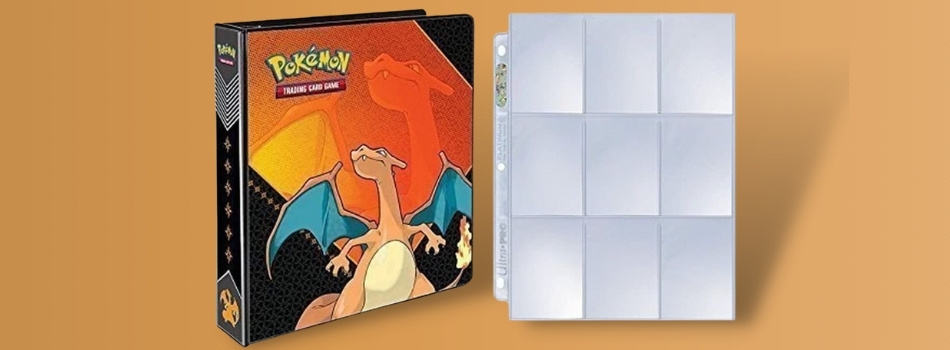
The benefit of using a ring binder for these less valuable cards is that it’s very easy to organize them since you can always add new pocket sheets and dividers to a ring binder.
Since you can always add to ring binders, I recommend sorting your Pokémon cards by color and adding new sheets to each color section whenever you need more space. Likewise, I recommend just getting a single ring binder, or maybe 2, if you have a lot of cards you don’t want to get rid of.
Just keep in mind, if you don’t consider yourself a collector, don’t hold onto cards you never plan to play with. It’s really easy to find yourself drowning in cards you have no need for that just take up closet space.
Trade or sell those cards for new cards you actually want to play with.
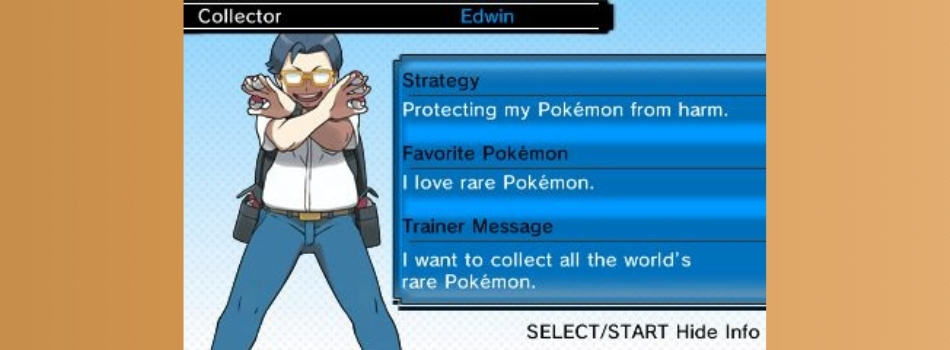
Organizing Pokemon Cards Using Binders For Collectors
For those of us that don’t have much interest in playing the Pokémon card game but love to collect the cards, I’d recommend going with a standard 3-row binder and not bothering with the 4-row binders.
There are a ton of different ways of going about collecting Pokémon cards, but if you are only interested in getting a single copy of each card to complete the set, then 3-row style binders can be more visually appealing when it comes to organizing Pokémon cards for non-players.
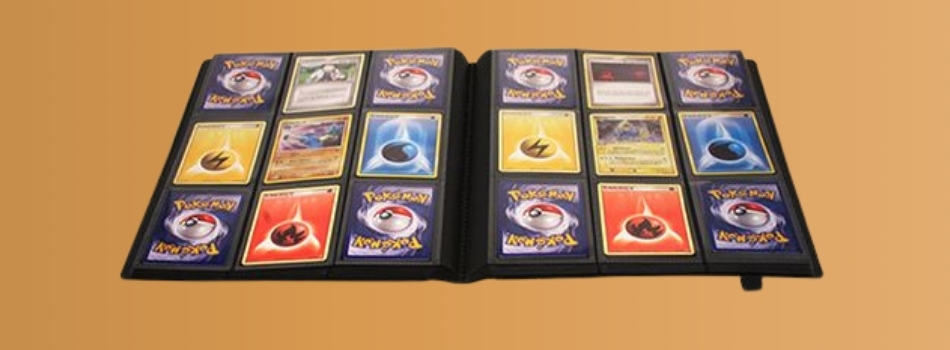
Although not always the case, there are a lot of Pokémon that have 3 stage evolutions and many collectors find it visually appealing to have the evolution chain fill up an entire row of a binder.
Currently, there is no Pokémon with a 4 stage evolution (assuming you don’t count mega evolutions), and so 3-row binders tend to work out pretty well for Pokémon card collectors.
Fun Fact: Pikachu was initially supposed to have another evolution after Raichu called “Gorochu” but got cut from the final list of Gen 1 Pokémon. With the later addition of Pichu, Pikachu would have been the only Pokémon to have a 4 stage evolution.
As a collector, when organizing your Pokemon collection in a binder, the best method is to organize cards by set and card set number.
For each Pokemon set that is released, each card within that set is designated a number out of the total number of cards in that set.
| Number | Name |
|---|---|
| 1/102 | Alakazam |
| 2/102 | Blastoise |
| 3/102 | Chansey |
| 4/102 | Charizard |
As you can see from the example, earlier sets of Pokemon cards were numbered in different ways such as Alphabetically (English base set) or by type (Japanese base set).
This is less than ideal when aiming for a visually appealing way to show off your cards in a binder. However, this shouldn’t be a problem unless you plan to collect vintage Pokemon cards.
Most modern sets organize Pokemon cards in a manner that has Pokémon ordered next to other Pokemon in their evolution chain.
| Card Number | Name |
|---|---|
| 020/202 | Gossifleur |
| 021/202 | Eldegoss |
| 022/202 | Vulpix |
| 023/202 | Ninetales |
If you do plan to collect vintage sets that have Pokémon cards in less than appealing orders, like cards from the original base set, then I recommend organizing your Pokémon cards in Pokedex order.
By using the Pokedex order from the original games and TV show for those few odd sets, you can really clean up the look of your card binder collection.
| #025 | Pikachu |
| #026 | Raichu |
| #027 | Sandshrew |
You could, in theory, do this for every Pokémon card set you collect, but things would start to look a bit messy once you begin collecting sets that have Pokémon from different generations present. I’d stick to using the set number method when possible.
The advantage of organizing Pokemon cards in binders by their set numbers is that you know exactly how much space an entire set is going to take up by looking at the total number of cards in a set.
This method also gives collectors a quick and clear visual reference as to which cards they’re currently missing in their collection by looking at the empty spaces in their binders.
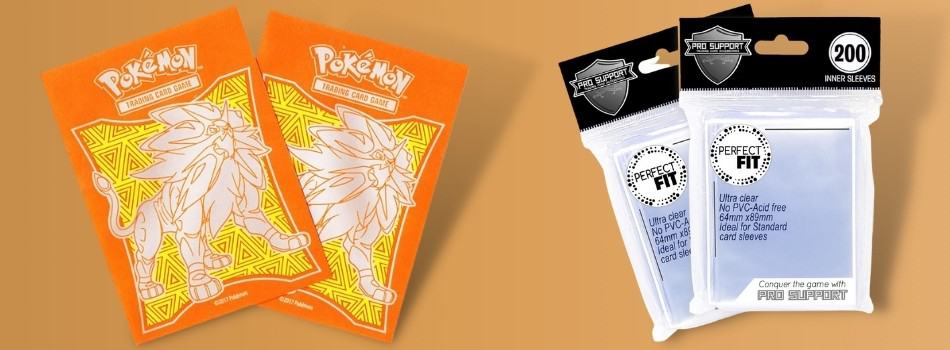
Should You Sleeve Cards In A Binder?
When placing cards in a binder you should sleeve them. Some card binders are built to store cards without sleeves, but the majority of premium binders provide enough space to place single-sleeved or double-sleeved cards within binder pockets. Sleeveless cards may move or fall out of binder pockets.
In order to keep your collection of Pokemon cards safe in your binders, I highly recommend that you at least single-sleeve your cards. The sleeve can be a standard size or a smaller, inner size sleeve, either should work well to keep your cards from accidentally falling out of your binders and getting damaged.
Avoid using penny sleeves as the majority of the time they will be too big to fit in most binder’s card pockets comfortably.
Regardless of whether you are a beginner, player or collector, however you choose to organize your Pokemon cards in binders can be a great form of self expression that is often over looked. One of the best things about collectible trading card games is that how we choose to interact with them isn’t dictated to us, instead, we decide what’s best for us and our collection.
Even if this guide only acts as a starting point for many of you to go out there and come up with your own systems for organizing your Pokemon binders, I hope it at least made the process a little less daunting for you.
This could just be a little OCD on my part, but I find that organizing and showing off your card collection can sometimes be just as fun as building your Pokemon card collection in the first place!
Here are some of my favorite TCG Accessories.
Thank you for reading this article. I hope you found it helpful on your TCG journey. After 20 years of being in the Trading Card Game community, I commonly get asked what my recommendations are on X products. To help save everyone a bit of time, I’ve listed below my top picks as a TCG collector that I hope you’ll also find helpful.
These are affiliate links, so if you do decide to use them, I’ll earn a commission. But in all honesty, these are the exact accessories that I use and recommend to everyone, even my own friends and family.
Sleeves: If you want the best for Magic and Pokemon cards, I really like Dragon Shield Matte Art sleeves. They have an excellent shuffling feel to them and have great durability, so you don’t have to worry about them breaking on you. If you want my full thoughts on these sleeves, check out my written sleeve review.
Binders: For competitive Magic and Pokemon players, go with the Vault X 12 Pocket Binder. I’m a big fan of 12 pocket binders for keeping playsets of 4 together and this binder is good quality without premium prices. For the pure TCG collectors, I would recommend Dragon Sheild 9 Pocket binders.
Deck Boxes: If you are looking for a solid deck box, then you can’t go wrong with Ultra Pro Towers. Fantastic protection at affordable prices, everything you need. If you want to get a bit fancy like me, go with the Gamegenic Watchtower.
